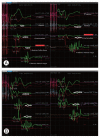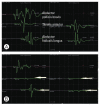Multimodal Intraoperative Neurophysiological Monitoring in Spine Surgeries: The Experience at a Spine Centre through Years
- PMID: 33371622
- PMCID: PMC8696063
- DOI: 10.31616/asj.2020.0400
Multimodal Intraoperative Neurophysiological Monitoring in Spine Surgeries: The Experience at a Spine Centre through Years
Abstract
Study design: Retrospective observational study.
Purpose: To share our experience of multimodal intraoperative neurophysiological monitoring (IONM) used in Sakra World Hospital, Bengaluru in various spine surgeries.
Overview of literature: The development of new onset postoperative neurological deficits can be completely avoided. In order to avoid these, IONM has become a standard of care in recent times for early detection and manipulation of the surgical procedure to prevent postoperative neurological deficits.
Methods: This retrospective study was performed on 408 patients who had undergone spine surgeries with IONM during April 2014 to March 2020 at a single center. The operative report, anesthesia record, and IONM were reviewed. All the patients were reassessed for postoperative neurological deficits in the postoperative period and followed up based on the intraoperative findings and neurological deficits for 4 weeks. Signal changes in IONM were reviewed, and the obtained results were further categorized into true positive, true negative, false positive, or false negative. If changes were observed during the IONM, the patients were managed as per the algorithm.
Results: Of the 408 patients being monitored continuously during the intraoperative period, 38 showed changes in recordings, 28 developed postoperative neurological deficits, and one developed neurological deficit without any change in the IONM. Nine patients had transient neurological deficits, and the other 20 had permanent neurological deficits. Overall, the multimodal IONM used in our study had a sensitivity of 96.6%, specificity of 97.4%, a positive predictive value of 73.7%, and a negative predictive value of 99.7%.
Conclusions: Use of decision algorithm and multimodal neuromonitoring consisting of motor evoked potentials, somatosensory evoked potentials, and electromyography complement each other in the detection of neurological injury during the course the surgery, improve intraoperative care, and prevent further damage and morbidity in patients.
Keywords: Electromyogram; Intraoperative neurophysiological monitoring; Motor evoked potentials; Somatosensory evoked potentials; Spine.
Conflict of interest statement
No potential conflict of interest relevant to this article was reported.
Figures



References
-
- Fehlings MG, Kato S, Lenke LG, et al. Incidence and risk factors of postoperative neurologic decline after complex adult spinal deformity surgery: results of the Scoli-RISK-1 study. Spine J. 2018;18:1733–40. - PubMed
-
- Nash CL, Jr, Lorig RA, Schatzinger LA, Brown RH. Spinal cord monitoring during operative treatment of the spine. Clin Orthop Relat Res. 1977;(126):100–5. - PubMed
-
- Khan MH, Smith PN, Balzer JR, et al. Intraoperative somatosensory evoked potential monitoring during cervical spine corpectomy surgery: experience with 508 cases. Spine (Phila Pa 1976) 2006;31:E105–13. - PubMed
-
- Merton PA, Morton HB. Stimulation of the cerebral cortex in the intact human subject. Nature. 1980;285:227. - PubMed
LinkOut - more resources
Full Text Sources
Research Materials
Miscellaneous

